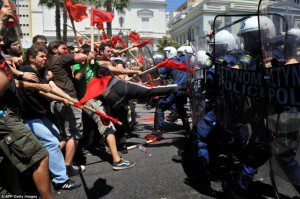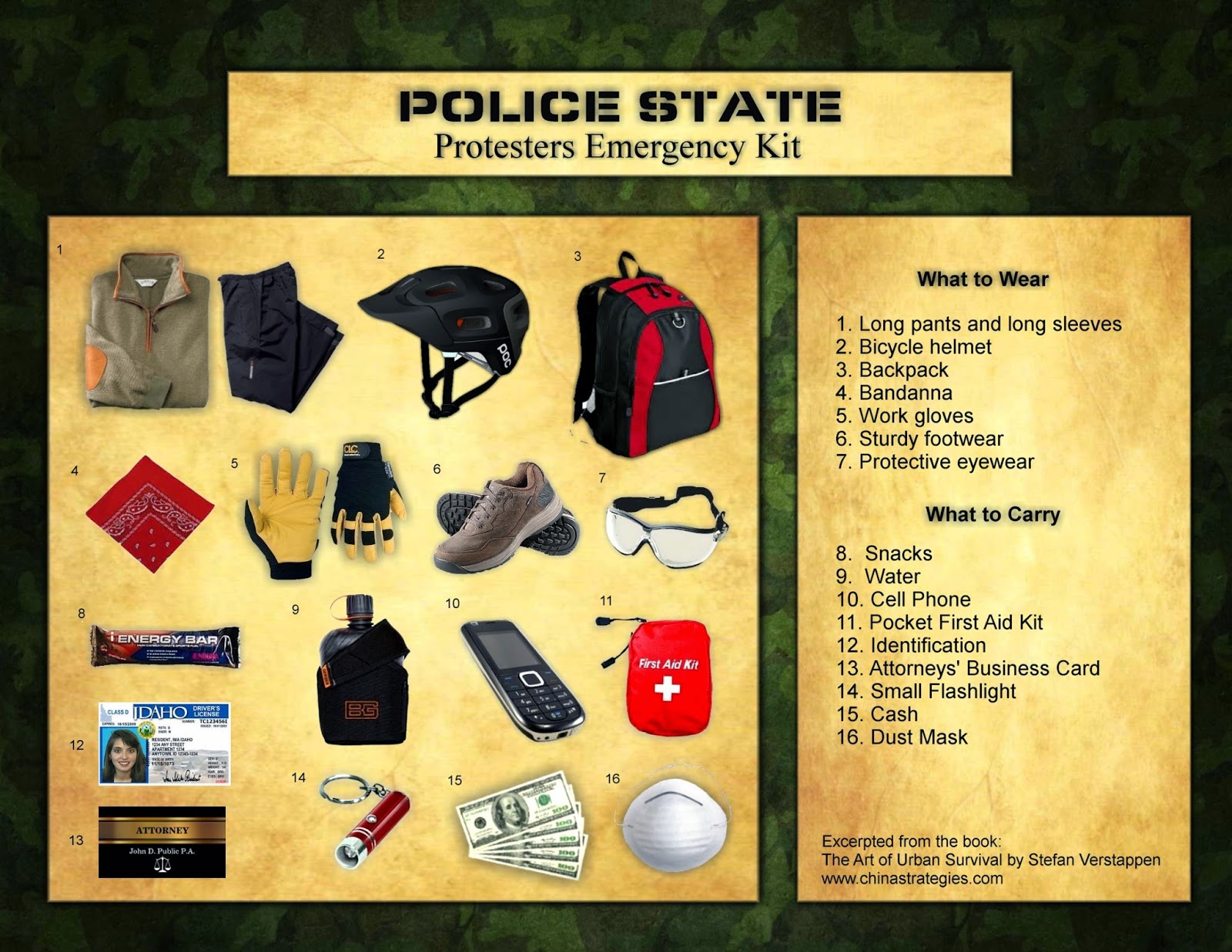Guest Writer for Wake Up World
If you’re planning on participating in a peaceful demonstration or protest, keep one thing in mind – it could turn at any time.
In the past it has been a common practice for governments to send agent provocateurs to mingle among the demonstrators until a given time or signal, and then to begin instigating violence as both a way to demonize the peaceful protesters in the media, and as an excuse to send in the riot troops to bust heads. As demonstrators around the world can attest to, this tactic has not gone out of fashion.
So what should you do if suddenly rubber bullets, tear gas canisters, and ‘flash bang’ grenades are whizzing past you while a hundred Mad Max extras with clubs start goose-stepping in your direction?
The following will provide you some tips and advice to keep you as safe as possible, should you suddenly find yourself in a riot situation.
How to Stay Safe When Exercising Your Rights
When the storm troopers make their appearance at your protest march, you’ll notice they came dressed to kill. They typically wear helmets, face shields, gas masks, chest protectors, elbow pads, knee and shin pads, and combat boots. In addition, they will carry shields, batons, tasers, radios, medical kits, shotguns and pistols. Meanwhile, you are standing there in a t-shirt and flip flops.
The first tip is to come dressed for the occasion.
What to Wear
Long pants and long sleeves. This reduces the exposure of skin to RCAs (Riot Control Agents like pepper spray and tear gas).
Wear only cotton or wool. Natural fibers are fire resistant whereas most synthetic materials are highly flammable and can quickly ignite from a spark, a Flash Bang (stun grenade) or Molotov cocktail. When these materials burn they will melt right into your skin and cannot be removed without taking the skin with it.
A bicycle helmet. This can be a life saver in case agitators begin throwing rocks and you happen to be in the line of fire. Also useful as protection against police nightstick attacks.
A backpack. Fill the book pocket, the pocket that is closest to the back straps, with a large hardcover book. This can act like body armor protecting your back from rubber bullets etc. In addition, it can be used as a shield by placing your forearm through the shoulder straps and holding the pack as a shield in front of you, if you have to escape volleys of projectiles.
A bandanna. This can be used as an emergency bandage, sweat band, improvised dust mask, and wash cloth.
Bring work gloves. Work gloves protect your hands if you have to escape through broken windows, or other sharp wreckage caused by rioting. Wearing gloves will also help prevent burns if you have to remove smoking tear-gas canisters.
Wear work boots or hiking boots, or at least good high top leather runners. This is to help protect your feet from broken glass and sharp debris on the ground, and will help support your ankles if running, or climbing over barriers.
Wear protective eye-wear. The sports style sunglasses with padding on the inside work best, like those used in racket ball and other sports. This is to protect against RCAs, rubber bullets and fragments from tear gas canisters and Flash Bangs.
What to Carry
Riot police typically carry a lot of gear and it is a good idea for you to carry some items on your person as well.
Water. You can quickly become dehydrated standing outdoors and access to water may be restricted. Local stores may be closed for fear of rioting and looting and police may block off access to public fountains and washrooms. Bring 2 litres minimum and double if the temperatures are high.
Snacks. The excitement and physical exertion can quickly use up your glucose stores and leave you feeling weak and nauseous. Bring some snacks to nibble on through the day to maintain your blood sugar levels.
Cell Phone. Useful to call for help, an attorney, or a cab to help you get out if you become trapped or arrested, a cell phone is can also be used for filming the violation of human rights.
Pocket First Aid Kit. Good for treating minor injuries like cuts and blisters. Add one or two a chemical cold packs to help treat welts raised by rubber bullets and baton strikes.
Small Flashlight. In case you’re out after dark and the power goes out…
Cash. Useful to pay for parking, or public transportation, or to hire a taxi.
Dust Mask. This helps filter out riot control agents.
Identification. Providing I.D. can get you released sooner, in case you are detained or arrested.
Attorneys’ Business Card. If you participate regularly in an activist community you will eventually have an encounter with law enforcement. It is best to be prepared ahead of any such encounter by finding a reputable lawyer that specializes in civil rights cases and get several of his or her business cards to keep in your wallet and another in your protest emergency kit. Don’t rely solely on your cell phone for contact information since cell phones and other electronic devices will be seized when you are arrested.
How to Deal With Riot Control Agents
The term “riot control agents” (RCAs) refers to several gases commonly known as ‘Tear Gas’ or ‘Pepper Spray’. Exposure to these chemicals can cause skin, nose, and eye irritation, nausea, and respiratory difficulties within minutes. In rare cases, RCAs can cause long-term health complications, blindness, and even death. The effects generally last less than half an hour but can be extremely uncomfortable.
The first defense is to try to stay out of the line of fire and away from the front lines of the police. If the chemicals are released in front of you, you should run straight behind you to get out of range. Try to get upwind of the point of release where there is fresh air.
If RCAs are deployed inside a building, get out as quickly as possible. The chemicals do not dissipate as they would outdoors, and the high concentrations can be extremely dangerous with prolonged exposure.
Get to high ground. RCAs are heavier than our air, and the highest concentrations thus tend to be nearer to the ground. Try to get to the highest point possible. This could be up a hill, atop a wall, etc.
If you are caught in a smoke cloud, soak a bandanna or other cloth in apple-cider vinegar or lemon juice and tightly cover your mouth and nose with it. (Bring these items in your kit.)
Finally, avoid wearing oil-based creams and sunscreens, as these aid absorption of the RCAs. If you are exposed to these agents, follow decontamination procedures.
In emergencies, dry powder such as flour, baking soda, detergents, or even soil can be used to reduce the quantity of chemical agent available for uptake through the skin. Pouring flour onto the chemical followed by wiping with wet tissue paper is reported to be effective against the nerve agents soman, VX, and mustard gas.
How to Escape a Riot
Try to look as inconspicuous as possible, and slowly and carefully move to the outside of the mob. Stay close to walls or other protective barriers if possible.
Get inside and stay inside if you can. Find a retail store, office building, or coffee shop to go into and off the streets. Look for a rear exit to these buildings that will lead out to a back street where there are no rioters or police and carefully make your way home.
It can be dangerous to move against a crowd, so go with the flow until you are able to escape into a doorway or up a side street or alley. It may also be advantageous to stay with the crowd until you are certain you can safely escape because it will help you remain inconspicuous and improve your odds of survival if shots are fired. In addition, police may barricade side routes and ambush anyone seeking to escape the main mob. You do not want to be the only person trying to get past a police barricade.
Avoid public transportation. Buses, subways, and trains will likely be out of service, and stations and depots will probably be packed with people. Even if you succeed in getting on a train or bus, rioters may stop it. Subway stations are particularly bad places to be, both because they are difficult to escape and because riot control agents are heavier than air and may drift down into subway stations and accumulate there.
Protesting in a police state can be a dangerous, however vital, exercise of your basic human rights. Despite the mood of any protest, you cannot trust that unstable elements within the ranks of law enforcement will not instigate violence that triggers the police into attack mode. You just don’t know. Protect yourself and fellow activists; make sure you follow the advice given and come prepared.
About the author:
 Stefan H. Verstappen is a Canadian writer, adventurer, and martial artist. He has worked as a wilderness survival instructor for Outward Bound programs, a street youth counselor, a First Aid and CPR instructor for St. John’s Ambulance, and a martial arts instructor. Since first backpacking alone through Europe at age sixteen, he has also traveled extensively and spent four years living in Asia.
Stefan H. Verstappen is a Canadian writer, adventurer, and martial artist. He has worked as a wilderness survival instructor for Outward Bound programs, a street youth counselor, a First Aid and CPR instructor for St. John’s Ambulance, and a martial arts instructor. Since first backpacking alone through Europe at age sixteen, he has also traveled extensively and spent four years living in Asia.
Check out more from Stefan at The Art of Urban Survival.

If you've ever found value in our articles, we'd greatly appreciate your support by purchasing Mindful Meditation Techniques for Kids - A Practical Guide for Adults to Empower Kids with the Gift of Inner Peace and Resilience for Life.
In the spirit of mindfulness, we encourage you to choose the paperback version. Delve into its pages away from screen glare and notifications, allowing yourself to fully immerse in the transformative practices within. The physical book enriches the learning process and serves as a tangible commitment to mindfulness, easily shared among family and friends.
Over the past few years, Wake Up World has faced significant online censorship, impacting our financial ability to stay online. Instead of soliciting donations, we're exploring win-win solutions with our readers to remain financially viable. Moving into book publishing, we hope to secure ongoing funds to continue our mission. With over 8,500 articles published in the past 13 years, we are committed to keeping our content free and accessible to everyone, without resorting to a paywall.








